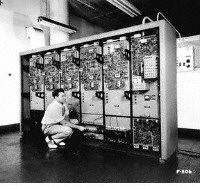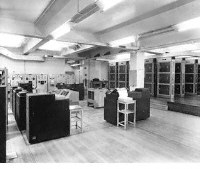|
|


 MIT Whirlwind
MIT Whirlwind
|
|
Computers
MIT's Whirlwind debuted on Edward R. Murrow's "See It Now" television
series. Project director Jay Forrester described the computer as a
"reliable operating system," running 35 hours a week at 90-percent
utility using an electrostatic tube memory.
| Start of project: |
1945 |
| Completed: |
1951 |
| Add time: |
.05 microseconds |
| Input/output: |
cathode ray tube, paper tape, magnetic tape |
| Memory size: |
2048 16-digit words |
| Memory type: |
cathode ray tube, magnetic drum, tape (1953 - core memory) |
| Technology: |
4,500 vacuum tubes, 14,800 diodes |
| Floor space: |
3,100 square feet |
| Project leaders: |
Jay Forrester and Robert Everett |

|
|
|
 LEO
LEO
|
|
Computers
England's first commercial computer, the Lyons Electronic Office, solved
clerical problems. The president of Lyons Tea Co. had the computer, modeled
after the EDSAC, built to solve the problem of daily scheduling production
and delivery of cakes to the Lyons tea shops. After the success of the first
LEO, Lyons went into business manufacturing computers to meet the growing need
for data processing systems.

|
|
|
 UNIVAC I
UNIVAC I
|
|
Computers
The UNIVAC I delivered to the U.S. Census Bureau was the first commercial
computer to attract widespread public attention. Although manufactured by
Remington Rand, the machine often was mistakenly referred to as the
"IBM UNIVAC." Remington Rand eventually sold 46 machines at more
than $1 million each.
| Speed: |
1,905 operations per second |
| Input/output: |
magnetic tape, unityper, printer |
| Memory size: |
1,000 12-digit words in delay lines |
| Memory type: |
delay lines, magnetic tape |
| Technology: |
serial vacuum tubes, delay lines, magnetic tape |
| Floor space: |
943 cubic feet |
| Cost: |
F.O.B. factory $750,000 plus $185,000 for a high
speed printer |
| Project leaders: |
J. Presper Eckert and John Mauchly |

|

|
|

|
|
